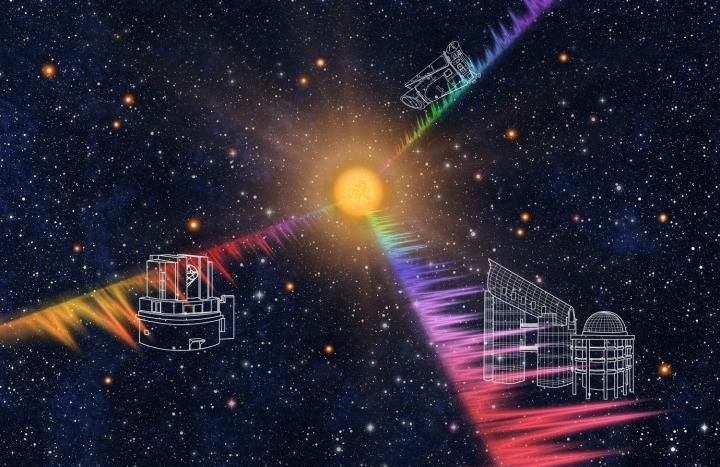Oct 6 2020
One of the ancient elements nearly as old as the universe is lithium. Although lithium is one of the building blocks of the present-day universe, the observations of lithium in several celestial bodies are usually in disagreement with the speculations of classic theories.
 Astronomers reveal the secrets of the lithium-rich low-mass evolved stars by monitoring their heartbeats and analyzing their spectra. Image Credit: YU Jingchuan, Beijing Planetarium.
Astronomers reveal the secrets of the lithium-rich low-mass evolved stars by monitoring their heartbeats and analyzing their spectra. Image Credit: YU Jingchuan, Beijing Planetarium.
Lithium-rich stars, which make up only 1% of all low-mass evolved stars, is one such example of contradiction. They retain up to thousands of times more lithium compared to the normal stars that account for the remaining 99%. Astronomers have been speculating what these stars are and why.
The latest study performed by an international group of researchers under the guidance of Prof. Zhao Gang, Prof. Shi Jianrong and Dr. Yan Hongliang from the National Astronomical Observatories of the Chinese Academy of Sciences (NAOC) offers new understanding about the lithium-rich stars. The study was reported in the Nature Astronomy journal on October 5th, 2020.
By tracking their “heartbeats,” the researchers identified that most lithium-rich stars are the so-called “red clumps” and not the “red giants” as believed earlier.
The ‘red clumps’ and ‘red giants’ are names for different stages of the senile stars. Though they look alike on the H-R diagram, a tool for mapping the evolutionary stage of a star over its lifetime. Imagine you are looking at two grey-haired elders it is very hard to tell who is older just by their appearances.
Zhao Gang, Study Co-Corresponding Author and Professor, National Astronomical Observatories, Chinese Academy of Sciences
Conventionally, convective movement in the “red giants” was believed to be a favorable setting for the development of lithium in stars. That partly accounts for why the majority of lithium-rich stars were thought to be “red giants” previously.
According to Dr. Yan, the lead author of this study, “The key problem is that we don't exactly know what the lithium-rich stars really are, but now we do.”
The turning point here is the combined use of spectroscopy and asteroseismology, a method that quantifies the characteristic of the oscillation of a star by supervising their light changes from a space satellite, Kepler, that is operated by the National Aeronautics and Space Administration (NASA).
We are monitoring the heartbeats, taking the cardiogram for stars. Although the 'red giants' and 'red clumps' are alike in appearances, they have different hearts, thus beat diversely.
Dr Yan Hongliang, National Astronomical Observatories, Chinese Academy of Sciences
In this research, the majority of lithium-rich stars were identified by the Large Sky Area Multi-Object Fiber Spectroscopic Telescope (LAMOST), a unique quasi-meridian reflecting Schmidt telescope with active optics method, situated in Xinglong station, China.
Also, few of these stars were spotted by other telescopes globally with different resolution, like the Subaru telescope operated by Japan, for verifying that the data derived from LAMOST data is right.
The spectra can tell us the physical parameters of the stars, and how much lithium are kept in their atmospheres. So, spectra are equally important as the ‘heartbeats’ of stars in our study.
Zhao Gang, Study Co-Corresponding Author and Professor, National Astronomical Observatories, Chinese Academy of Sciences
The study demonstrates that more than 80% of lithium-rich stars are “red clumps”. Moreover, essentially it discloses a lot of new signatures for lithium-rich stars while their “heartbeats” help to categorize individual stars into “red giants” or “red clumps.”
According to Professor Shi, the other co-corresponding author of the paper, “All of these signatures are hard to explain using the current scenarios. There is still some unknown processes that could significantly affect surface chemical composition in low-mass stellar evolution, but this is an exciting opportunity for us astronomers to find out how lithium is created in stars.”
The study has been done by an international group with researchers from institutes worldwide, such as Denmark, Australia, United States, Netherlands, France, Japan, and China.
In addition to LAMOST, Subaru, and Kepler, four other telescopes contributed the data, such as the 3.5 m telescope at Apache Point Observatory, the Automated Planet Finder telescope at Lick Observatory, the 2.4-m and 1.8-m telescope at Lijiang Observatory.
Journal Reference
Yan, H.-L., et al. (2020) Most lithium-rich low-mass evolved stars revealed as red clump stars by asteroseismology and spectroscopy. Nature Astronomy. doi.org/10.1038/s41550-020-01217-8.